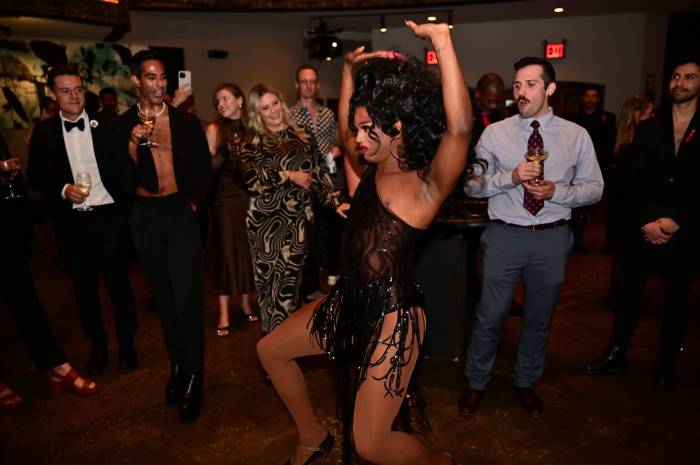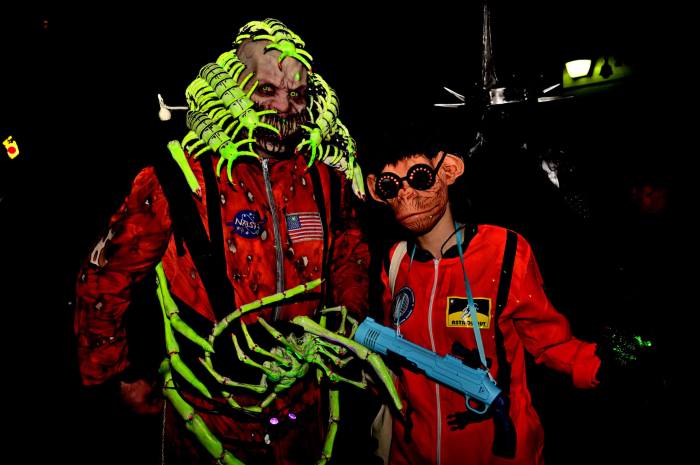More gorgeous bodies are in evidence in the book, “Allure” (Bruno Gmunder), which features the male-glorifying work of Robert W. Richards. Richards, a familiar figure for years on the New York scene, a true dandy, always nattily turned out with his trademark owl specs, imbues his figures with the aching sexiness stemming from his own wonderful, personally free nature and longtime fascination with the “gods' of pornography whom he has been immortalizing on paper since the '70s, the subject of his next book.
By: DAVID NOH
The Film Society of Lincoln Center's Dance on Camera Festival (filmlinc.com, through January 13) is the perfect antidote to lift you out of any lingering post-holiday doldrums. 15 different programs celebrate the glory of the human form in movement through the ages in a myriad of different worlds.
Dominique Delouche's “Serge Lifar Musagete” is one of the greatest dance films I have ever seen, honoring an artistically important figure too-little known in this country. Lifar (1905-86) was the successor to Nijinsky as both star of the Ballets Russes and lover of impresario Serge Diaghilev. He went on to become ballet master and director of the Paris Opera Ballet from 1929 to 1957, creating surpassingly elegant, innovation-filled dances, which broke new choreographic ground. Described as “suffocatingly beautiful, a Praxiteles statue come to life,” Lifar also brought a startling virility, as one dancer describes it, “He was not interested in the fifth position, and said, 'There are six positions, maybe seven, and the sixth is feet together.'”
Lifar's two great muses, Yvette Chauviré and Nina Vyroubova-for whom he created the plié en pointe movement-illuminate the film with footage of them rehearsing younger dancers in their famous roles, proving that they are not only magnificent ballerinas, but real actresses, as well. Chauviré is particularly enlightening about Lifar's blacklisting, following WWII, in which he was accused of collaboration. He left the Paris Opera and found work in Monte Carlo, returned for more triumphs in 1947, but was unceremoniously dismissed in 1957, sadly commenting, “The young never forgive their parents.” Delouche includes much footage of the great man, himself, as in his recreation of “Afternoon of a Faun,” filmed near Versailles' Temple of Venus, in which, perceiving it from Mallarmé's poem as the dream of the faun, he stripped the ballet of all nymphs and props, save that single piece of orgasmic tulle. It truly confirms the words of Jean Cocteau, “Each time Lifar dances, I see blood/His knees are bruised, his mouth is a wound, his veins are open/He's literally running with this blood of the soul/the loss of which exhausts us and which is the sweat of love/So dance, rather than being a somewhat ridiculous art, rediscovers its sublime and religious nature.”
“She was our queen,” observes the divine Carmen de Lavallade in Annette von Wangenheim's “Josephine Baker: Black Diva in a White Man's World.” This pioneering American black star indeed looks every inch a sovereign, gowned by Lanvin, surrounded by a tuxedoed male chorus, warbling her theme song, “J'ai deux amours,” in her small but entrancingly fluty, girlish voice. She kept singing this ode to her two “loves,” France and America, even though her own country never gave her much in return. Baker had to leave the racist America of the 1920s to become a star in Paris and, even when she returned, was never embraced as she should have been. Besides her performing artistry, which included comfort with nudity and love of goofy facial expressions that stemmed from the maligned minstrel tradition-and which was carried on by everyone from Fannie Brice to Amy Sedaris today-she was a social visionary and utter humanitarian. She worked for the French Resistance in WWII and adopted twelve children of different races, which she raised in a chateau as a model of what an ideal integrated society should be. Arthur Mitchell and Maurice Hines weigh in with laudatory opnions of Baker, and Geoffrey Holder is seen in one beguiling clip, dancing with de Lavallade in Paris, as an ageless Baker, sexily svelte into her sixties, warbles Jerome Kern's “Bill.”
Gerhard Schick's “Invitation to the Dance: Body and Taboo,” shot in Kenya, is an inspiring work about dancer Gerda Koenig, whose muscular dystrophy hasn't stopped her from helping other physically disabled dancers do their thing. Gene Kelly's similarly titled “Invitation to the Dance” is being given a rare screening, as well, on the occasion of its fiftieth anniversary. This was Kelly's debut as a solo director-choreographer, an artistically ambitious but commercially disastrous collection of three ballets incorporating the diverse talents of Tamara Toumanova, Carol Haney, Igor Youskevitch, Diana Adams and animation by Hanna-Barbera. Choreographers William Forsythe, Merce Cunningham and Mark Morris are featured, respectively in the films, “One Flat Thing, Reproduced,” “Biped,” and “Dido and Aeneas.” “Lucinda Childs” is a documentary, whose subject is obvious, as well as one, “Alberto & Carmen,” which details the historic ballet the now 87-year-old Alberto Alonso created for Maya Plisetskaya and the Bolshoi in 1967.
More gorgeous bodies are in evidence in the book, “Allure” (Bruno Gmunder), which features the male-glorifying work of Robert W. Richards. Richards, a familiar figure for years on the New York scene, a true dandy, always nattily turned out with his trademark owl specs, imbues his figures with the aching sexiness stemming from his own wonderful, personally free nature and longtime fascination with the “gods' of pornography whom he has been immortalizing on paper since the '70s, the subject of his next book.
Richards was originally a fashion illustrator but came to realize that the field was becoming played out for him, especially with the rise in the '70s of the great Antonio Lopez “whose work went in a direction that was beyond anything anyone else could do.” He wanted to explore the male form more closely, especially what went on beneath stylish clothes, so he submitted work to gay publications like Torso, Mandate, Stallion and the Advocate, and lo! a new career was born.
“It's the duty of every attractive young guy to be captured at least once, naked and hard,” is Richard's quite sensible artistic philosophy, but he has also continued to work commercially, with artwork for various prominent beauty/fashion clients, and celebrities from Ann Margret to Julie Wilson. At a recent personal appearance at Leslie Lohman gallery, his drawings were selling like hotcakes, and I was personally craving mightily his Marilyn Monroe portrait, a definitive study if e'er there was.
It's just a shame that Harley Granville Barker, playwright of “The Voysey Inheritance,” has been dead for sixty years. No matter, the Atlantic Theatre production is superlatively adapted and directed by David Mamet and David Warren, respectively, and sumptuously designed and costumed-the audience almost weeps in gratitude for one of the few real sets on a NY stage-and acted by a strong ensemble cast which recalls the memorable family units of, in various media, “The Magnificent Ambersons,” “The Forsyte Saga,” and Anthony Trollope's “The Way We Live Now.” Standouts include Michael Stuhlbarg who has an uncanny, tortured Christ-like goodness, and the magnificently harrumphing Peter Maloney.
Contact David Noh at Inthenoh@aol.com


































